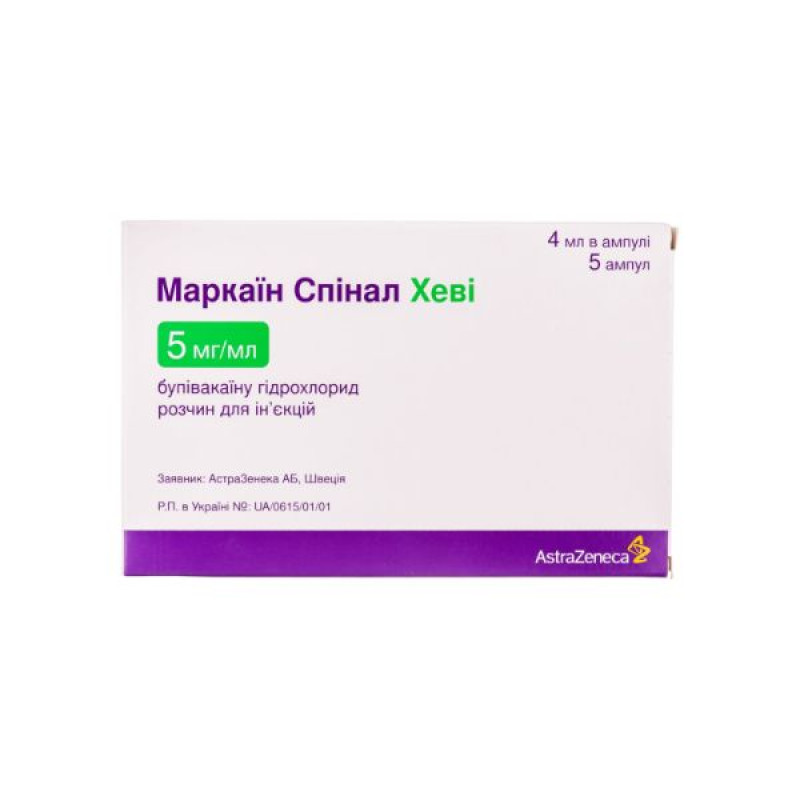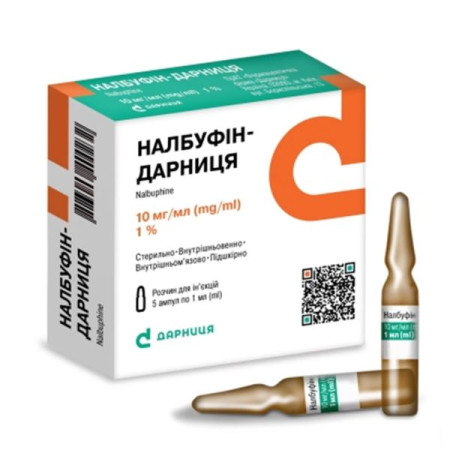Marcaine Spinal Heavy solution for injection 5 mg/ml ampoule 4 ml No. 5

Marcaine Spinal Heavy injection solution is indicated for adults and children of all ages for intrathecal (subarachnoid) spinal anesthesia in surgery (urological and lower extremity surgeries lasting 2-3 hours, as well as abdominal surgeries lasting 45-60 minutes).
Composition
The active substance is bupivacaine hydrochloride (1 ml of solution contains 5.28 mg of bupivacaine hydrochloride monohydrate, equivalent to 5 mg of bupivacaine hydrochloride).
Excipients: glucose, monohydrate; sodium hydroxide and/or hydrochloric acid, water for injections.
Contraindication
Hypersensitivity to the active substance, amide local anesthetics or to any component of the drug.
Intrathecal anesthesia, regardless of the local anesthetic used, has its own contraindications, which include:
Active central nervous system diseases such as meningitis, poliomyelitis, intracranial hemorrhages, subacute combined degeneration of the spinal cord due to pernicious anemia and tumors of the brain and spinal cord; spinal stenosis and diseases in the active stage (e.g. spondylitis, tuberculosis, tumors) or recent injuries (e.g. spinal fracture); septicemia; purulent skin infection at or near the lumbar puncture site; cardiogenic or hypovolemic shock; blood clotting disorders or continued treatment with anticoagulants.Method of application
Marcaine Spinal Heavy should only be used by physicians experienced in regional anesthesia or administered under their supervision in small doses that allow for sufficient anesthesia.
The recommended doses of the drug below should be considered as a guide to the use of the drug in adults, dose adjustment should be performed individually for each patient.
The dose of the drug should be reduced for elderly patients and patients in the late stages of pregnancy.
Recommended dosage:
urological surgeries - 1.5-3 ml (7.5-15 mg); time to onset of effect (approximately) - 5-8 minutes; duration of effect (approximately) - 2-3 hours; lower limb surgeries, including hip surgeries - 2-4 ml (10-20 mg); time to onset of effect (approximately) - 5-8 minutes; duration of effect (approximately) - 2-3 hours; abdominal surgeries (including cesarean section) - 2-4 ml (10-20 mg); time to onset of effect (approximately) - 5-8 minutes; duration of effect (approximately) - 3/4-1 hour.The recommended injection site is below L 3.
Currently, there is no clinical experience with doses above 20 mg.
Spinal administration of the drug is performed only after a clear definition of the subarachnoid space by lumbar puncture (until clear cerebrospinal fluid is obtained through the lumbar puncture needle or during aspiration). In case of ineffective anesthesia, a new attempt to administer the drug should be made only at a different level with a smaller volume of anesthetic. One of the reasons for the insufficient effect may be incorrect distribution of the drug in the intrathecal space. In this case, a sufficient effect is achieved by changing the patient's body position.
Newborns, infants and children weighing up to 40 kg
"Marcain Spinal Heavy" can be used in pediatric practice.
One difference between children and adults is the relatively high volume of cerebrospinal fluid in infants and neonates, which requires a relatively higher dose/kg body weight to achieve the same level of blockade compared to adults.
Regional anesthesia procedures in children should be performed by qualified physicians who have appropriate experience in performing regional anesthesia in children, as well as experience in performing anesthesia techniques.
The doses given below should be considered as guidelines for use in pediatrics. Individual variability has been observed. Standard dosage recommendations should be considered in the presence of factors affecting individual blockade techniques and to ensure that individual patient requirements are met.
The lowest doses of the drug necessary to achieve adequate anesthesia should be used.
Dosage recommendations for newborns, infants and children (body weight):
<5 kg - 0.40-0.50 mg/kg; from 5 to 15 kg - 0.30-0.40 mg/kg; from 15 to 40 kg - 0.25-0.30 mg/kg.Application features
Pregnant women
There are no known risks to the fetus when used during pregnancy. It should be noted that the dose of the drug should be reduced for patients in late pregnancy.
Bupivacaine passes into breast milk, but the risk of exposure to the child when using therapeutic doses of the drug is unlikely.
Drivers
Depending on the dose and method of administration, bupivacaine may cause temporary impairment of motor activity and alertness.
Overdose
Acute systemic toxicity
When using high doses of bupivacaine, toxic effects on the central nervous and cardiovascular systems are possible, especially when administered intravascularly. However, in spinal anesthesia, low doses are used, so the risk of overdose is unlikely. In the case of simultaneous use with other local anesthetics, systemic toxic reactions may occur, since the toxic effects are additive.
In the case of a total spinal block, adequate ventilation of the lungs should be ensured (patency of the patient's airway, oxygen supply, intubation and mechanical ventilation, if necessary). In case of a decrease in blood pressure / bradycardia, a vasoconstrictor should be administered (preferably with an effect).
If signs of acute systemic toxicity occur, local anesthetics should be discontinued immediately. Treatment should be directed at maintaining adequate ventilation, oxygenation, and circulation.
Oxygen should always be provided and, if necessary, artificial ventilation of the lungs (possibly with hyperventilation) should be carried out. Diazepam should be used in case of convulsions, and atropine in case of bradycardia. In case of circulatory shock, fluids, dobutamine and, if necessary, noradrenaline should be administered (initially 0.05 mcg/kg/min, increasing the dose if necessary by 0.05 mcg/kg/min every 10 min), based on the results of hemodynamic monitoring in more severe cases. Ephedrine may also be used. In case of circulatory arrest, resuscitation measures may be indicated for several hours. Any acidosis should be corrected.
Side effects
Adverse reactions caused by the drug itself are difficult to distinguish from physiological effects related to nerve fiber blockade (e.g., decreased blood pressure, bradycardia, temporary urinary retention), conditions caused directly by the procedure (e.g., spinal hematoma) or indirectly by the needle puncture (e.g., meningitis, epidural abscess), or conditions related to cerebrospinal fluid leakage (e.g., headache that develops after dural puncture).
Cardiac disorders: very common (> 1/10) - hypotension, bradycardia.
From the gastrointestinal tract: very often (> 1/10) - nausea; often (> 1/100; <1/10) - vomiting.
From the nervous system: often (> 1/100; <1/10) - headache that develops after puncture of the dura mater.
Renal and urinary disorders: common (> 1/100; <1/10) - urinary retention, urinary incontinence.
Storage conditions
Store at a temperature not exceeding 25 °C, out of the reach of children.
Shelf life - 3 years.
There are no reviews for this product.
There are no reviews for this product, be the first to leave your review.
No questions about this product, be the first and ask your question.






